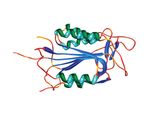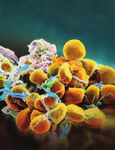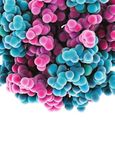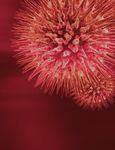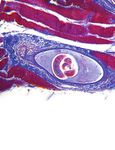Alois Alzheimer and Gaetano Perusini: should man divide what fate united?
←
→
Page content transcription
If your browser does not render page correctly, please read the page content below
Behavioural Neurology (1997), 10, 105-108 HISTORY Alois Alzheimer and Gaetano Perusini: should man divide what fate united? G. Macchi1, C. Brahe2 and M. Pomponi 3 '/stituto Neurologia; 2/stituto Genetica Medica and 3/stituto Chimica e Chimica Clinica, Catholic University, School of Medicine '.:4. Gemelli", Rome, Italy Correspondence to: M. Pomponi, Istituto di Chimica e Chimica Clinica, Catholic University, School of Medicine '.:4.Gemelli", Largo F. Vito, 1, 00168 Rome, Italy Three points of interest lie in considering how Alzheimer, and more significantly Perusini, struggled to throw light on the cause of this devastating disease. There is a stimulating possibility that Perusini believed presenile forms of Alzheimer's disease described the same disease as senile forms. If so this would anticipate current opinion, and reveal Perusini to dissent from Kraepelin. In addition, Perusini may have understood the pathological relationship between neuritic plaques and vascular changes, once more foreseeing the modern view of Alzheimer's disease. Finally, Perusini and Alzheimer disagreed with Jung's view concerning the relationship between neuropathology and clinical psychiatry. This point high- lights the major change occurring at that time from classical neurology to the psychoanalytic era. In his last work (1911) Alzheimer quoted his Italian disciple many times, even speaking of 'Perusini's cases' (Perusinischen Faile). This article is an attempt to change the eponym of Alzheimer's disease into the Alzheimer-Perusini disease. This is a brief history of a master and his disciple, whose scientific lives were, by events, divided. Keywords: Alzheimer's disease - Gaetano Perusini - Emil Kraepelin. This article originally appeared in European Journal of Neurology (1997),4,210-213 In 1986, Amaducci et al. described in detail the contri- tion of Dr. Alzheimer I have examined the four cases". bution of the Italian neuropathologist Gaetano It is a pity that the report did not contain a short Perusini (1879-1915) to the study and classification appendix indicating the year in which Perusini started of Alzheimer's disease (Amaducci et al., 1986). his study. Previously, in 1970, McMenemey recognized Perusini's The early history of this disease dates back to when contribution: "Perusini's four cases published in 1910 Alzheimer presented for the first time his famous case [even if already accepted for publication in 1908] were at the Psychiatric Convention of the South West more straightforward ... Italian writers have under- German Society in Tubingen (1906, 1907). There was standably called it the Alzheimer-Perusini disease." no discussion following his presentation and no head- (McMenemey, 1970). line or reference made to it in the Neurologische In the foreword of their book The Early History of Centralblatt (1906). At the same meeting, Ludwig Alzheimer's Disease, Bick and Amaducci reported in Frank (Zurich) and Bezzola (Schlo~ Hard) presented 1987, "we have much more to learn ... we can see that data regarding Freud's method and the application of the path was clearly outlined by these pioneers". These this approach by his disciple, Jung (BurghOlzli, authors, generously, mentioned Gaetano Perusini and Zurich). The subsequent discussion reported the con- quoted two papers now available in English (Bick and tribution by Jung himself, Hoche (Freiburg), Isserlin Amaducci, 1987); the first study (Perusini, 1910) was (Heidelberg) and Gaupp (Tubingen). It is possible that originally in German while the second paper (Perusini, Perusini was also present at Tubingen, considering that 1911) was translated from the Italian. At the beginning he was in Zurich during that year. He used to partici- of the first Perusini study (54 pages and 79 figures con- pate in interesting night meetings between very differ- tained in four tables) the author stated: "On sugges- ent schools, "die Somatiker und die Psychiker", which 0953-4180 © 1997 Rapid Science Ltd Behavioural Neurology. VollO . 1997 105
G. MACCHI ET AL.
argued about the neuroanatomic (Constantin von Still regarding this quarrel, Perusini (Perusini, 1910)
Monakow) and the psychoanalytic (Bleuler, lung) stated:
roles in the classification of mental illnesses (Perusini,
"It is very likely that the plaques I have outlined
1909).
In 1911 Alzheimer proposed the separation of pre- are the same as those reported by Fischer and
senile and senile dementia, a question which is still a Hubner. Nevertheless it should be stressed that
source of discussion to this day: "In 1906 I described a neither Fischer nor Hubner outlined the quite
case of the disease ... because senile dementia was out unique fibrillary changes. In my case histories, on
of the question since the patient was only 56 years old". the other hand, the concurrence of the fibrillary
Interestingly, Perusini, who was a member of the same changes with the formation of the plaques is
histopathological school, preferred to report the case clearly an essential finding .... What distinguishes
described by his mentor in 1906 and three other cases findings in our cases from those of senile demen-
of patients of 47, 67 and 63 years old (Perusini, 1910). tia are primarily quantitative differences ... even
By including the older patients, did Perusini doubt that though we are partly dealing with pre-senile
the disease was a characteristic of presenium? If so, diseases ... " .
this would have foreshadowed the modern view and However, in 1911, Perusini was more explicit: "in the
shown how Perusini differed from Kraepelin. It is pos- other cases, outlined by both Alzheimer and Perusini,
sible that Kraepelin influenced Alzheimer to express
the histopathological changes always were in agree-
views different from those of Perusini. In fact,
ment with those detected in the severest forms of
Alzheimer himself appeared to be uncertain of how to
senile dementia". This comment and the older patients
explain the significance of his research (Alzheimer,
of his study show that Perusini believed that presenile
1911): "Perusini has pointed out that the fibrillary
dementia and senile dementia were one disease. In
changes in nerve cells which I had described are also
seen in severe cases of Dementia senilis". On the other 1911 Alzheimer showed high esteem and recognition
hand, Kraepelin claimed that the form described by when he stated: "Perusini believes that these cases
Alzheimer could not be considered senile dementia characterize a distinct disease, partly for clinical and
due to the age of onset (senium praecox) in spite of partly for histological reasons". Again, in the same
histopathological findings which were very similar to year, Alzheimer said: "Fischer has given a complete
those found in the most serious forms of senile demen- account of Perusini's cases within his study". This is
tia. In conformity with his ideas, Kraepelin called it perhaps the best acknowledgement of Perusini's work:
Alzheimer's disease. However, in another case, Alzheimer himself speaking of "Perusini's cases"
Perusini seemed to be closely connected with the (Perusinischen Fiille). Why does Alzheimer pay such a
Munich school. In fact, he believed (as did Alzheimer generous tribute to his disciple?
and Kraepelin) that the interpretation of the new dis- How can we call this disease Alzheimer's disease
order had to be different from the one given by Oskar after this recognition and not Alzheimer-Perusini
Fischer (Fischer, 1910). This author considered the disease? Why is Alzheimer so generous with the young
plaques as characteristic of a specific disorder, while researcher? The following considerations made by
being absent both in normal ageing and non-pres- Perusini are helpful as well as other fascinating theo-
byophrenic disorders. Nevertheless, the integration ries contained in his study (Perusini, 1910) that are
plaques=presbyophrenia was largely and easily worth reporting:
disputed by numerous authors (Perusini, 1909; also
references above). Moreover, Alzheimer added "I believe that I can give evidence that the free
(Alzheimer, 1911): "Perusini's and Kraepelin's reser- plaques and those around the vessels ... must be
vations against this integration have not been convinc- considered identical ... pathological metabolic
ingly eliminated by Fischer's arguments". Notably, products of an unknown kind ... Luckily I was in
Alzheimer, in reporting his reservations against the a situation where I was able to examine the many
integration plaques = presbyophrenia, cited Perusini preparations of Dr. Achucarro ... morphologi-
ahead of Kraepelin. At the beginning of the 20th cally, I have never seen in rabies such cells con-
century, could a German researcher (Alzheimer) with- sisting only of entangled fibril bundles which are
out reason quote an unknown Italian researcher made up of fibrillary tangles that are often
(Perusini) ahead of his unquestionable master and present in my case histories ... we can perceive
"boss" (Kraepelin)? The only explanation is that (naturally we can speak only of perception) that
Alzheimer's esteem of Perusini was such that he a kind of cement substance glued the fibrils
shared his views. together".
106 Behavioural Neurology. VallO. 1997ALOIS ALZHEIMER AND GAETANO PERUSINI
Perusini became aware of the presence of something possible that Kraepelin was responsible for influencing
that is now known as f3-amyloid peptide and which is Alzheimer and Perusini to differ in their views. Fate,
enriched in intermolecular hydrogen bonding which however, had already bound their lives; both had
leads to the f3-pleated sheet structure and its charac- strong roots in the upper classes (G.P. in the upper
teristic low solubility. Still, "I believe that the progres- class and A.A. in the upper middle class); both were
sive alteration of blood vessels ... could be related rich and united by a common interest in meticulous but
mainly to the severe decomposition of the neuronal ponderous neuropathological description. Moreover,
parenchyma". The relationship between the progres- Perusini could speak fluent German, his second
sive alteration of blood vessels and the severe decom- mother tongue. In fact, the Perusinis lived in the small
position of the neurons is an enigma that is still a village of Cormons in Friuli which, at that time, was
source of speculation to this day. part of the Austro-Hungarian empire. Andrea
The young researcher also commented on the mech- Perusini, Gaetano's father, was a good friend of the
anism of the disease (Perusini, 1910) anticipating the Habsburg bourgeoisie. In his castle (Rocca Bernarda)
modern considerations of AD: "Obviously, it remains at Cormons, there was a statue of Maximillian, brother
an open question whether a noxious agent, which of the emperor Francis Joseph. Furthermore, due to
causes the whole disease, also acts on the blood vessels, the socio-economic and scientific importance of the
or equally damages both the neuron and the blood German language, he wanted a German governess
vessels". In 1984, Wong et at., reported that the amy-
from Munich for his sons. However, to comply with
loid in neuritic plaques shares antigenic determinants
social conventions, he also wanted all three sons to be
withfl-protein of the cerebrovascular amyloid. Perusini
born in Udine (Regno d'Italia), where he had been
highlighted the first correlation between blood vessels
physician and director of the city hospital since 1866.
changes and the decay of the neurons (Pomponi and
Gaetano, his first son, was born in 1879. After receiv-
Marta, 1992). These impressive comments, resulting
ing a degree in medicine at Rome University, he spent
from this young researcher's extraordinary scientific
ability, would be sufficient justification for the eponym the majority of his years in neuropathological research
of Alzheimer-Perusini disease (Macchi, 1992). in Munich and Zurich, where Perusini knew Jung
Perusini also insisted on the tight link between mind (Perusini, 1909) and in Rome where he was the insep-
and brain. In fact, he believed that the studies carried arable friend of U go Cerletti.
out by the Alzheimer school were very useful in In 1912, Perusini's collaboration with Alzheimer
demonstrating their close relationship and from which ended. His master, in fact, had been called to the
progress could be made in the knowledge of mental ill- University of Breslau (Wroclaw), but at this point
ness. He had faith in the histopathological study of the Alzheimer's scientific career ended, possibly for health
brain because these findings showed some remarkable reasons. The young Italian disciple no longer went to
data which were very important for clinical psychiatry the psychiatric clinic in Munich and never again met
and nosography of mental diseases (Perusini, 1911). with Alzheimer. However, fate, although indirectly,
On this point Perusini disagreed (as did the Munich was to reunite them at the end of their lives. Perusini
school) with the non-organic causes of mental disease: died on 8 December 1915, while helping some
wounded soldiers (he received a silver medal for
'The aphorism of Jung is that the pathological
bravery in the First World War). He was buried in his
anatomy is useless .... I believe that the pathology
hometown of Cormons. Alzheimer died one month
is the study of altered molecular processes ... the
later, presumably from endocarditis. A few years later
consciousness is bound to material cerebral
processes ... depends on chemical physical Nissl died too and an era ended. Freud's theories were
law ... I believe that the Alzheimer studies show a triumphing.
close relationship between neuropathological and It is a pity that scientists working in this field of
clinical psychiatry ... " (Perusini, 1909). research, particularly American neurologists, are
unaware of Perusini's role in defining what we call
This not only highlights the major change occurring Alzheimer's disease. However, we can still hope that
at that time from classical neurology to the psychoana- McMenemey's acknowledgement will sooner or later
lytic era but the echo is still present with similar debate be rediscovered.
in our time.
In conclusion, Alzheimer reported only one very Acknowledgement
uncertain case up until 1911 although Kraepelin had The authors wish to thank Carolyn A. Waldron for editing
recorded ''Alzheimer's disease" (Kraepelin, 1910). It is the manuscript.
Behavioural Neurology. Vol 10 • 1997 107G. MACCHI ET AL.
REFERENCES Corain), Advances in the Biosciences, Vol. 87. Oxford,
Pergamon.
Alzheimer A (1906) Uber einen eigenartigen schweren McMenemey WH (1970) Alois Alzheimer and his disease.
EkrankungsprozeB der Hirnrinde. XX?,VII In: Alzheimer's Disease and Related Conditions (Eds
Verammlung siidwestdeutscher Irrenarzte in Tiibmgen GEW Wolstenholme and M O'Connor) pp. 5-9.
am 3 and 4 Nov. Neurologische Centralblatt, 1134. London, Churchill (Ciba Foundation).
Alzheimer A (1907) Uber eine eigenartige Erkrankung der Perusini G (1909) ~anatomia patologica in psichiatria.
Hirnrinde. Allgemeine Zeitschrift fUr Psychiatrie und Rivista Sperimentale di Freniatria, XXXV, 298-342
Psychisch-Gerichtliche M edizin, LXIV, 146-148. Perusini G (1910) Uber klinisch und histologisch eigenar-
Alzheimer A (1911) Uber eigenartige Krankheitsfaelle des tige psychische Erkrankungen . des spat.eren
spateren Alters. ZeitschriJt fUr die gesamte Neurologie und Lebensalters. Histologische und Hlstopathologlsche
Psychiatrie, Bd 4, Heft 3, 356-385. Arbeiten, Bd III, Heft 2, 197-35l.
Amaducci LA, Rocca WA and Schoenberg BS (1986) Perusini G (1911) Sui valore nosografico di alcuni reperti
Origin of the distinction between Alzheimer's disease istopatologici caratteristici per la senilita. Rivista i.taliana
and senile dementia: how history can clarify nosology. di Neuropatologia, Psichiatria ed Elettroterapza, IV,
Neurology, 36, 1497-1499. 145-171 (there is an English translation of this paper in
Bick K and Amaducci L (1987) Foreword. In: The Early reference 4).
History of Alzheimer's Disease (Eds K Bick, L Amaducci
Pomponi M and Marta M (1992) "On the. suggestion of D~;
and G Pepeu), p. 8, Padova, G Liviana Editrice. Alzheimer I examined the followmg four cases.
Fischer 0 (1910) Die presbyophrene Demenz, deren
Dedicated to Gaetano Perusini. Ageing, Clinical and
anatomische Grundlage und klinische Abgrenzung
Experimental Research, 5, 135-139. ..
Miliare Zeitschrift fur die gesamte Neurologie und
Wong Cw, Quaranta V and Glenner GG (1984) Neunttc
Psychiatrie, Bd 3, Heft 4, 471- 479. .
Plaques and cerebrovascular amyloid. in Alzheimer. dis-
Kraepelin E (1910) Psychiatrie: ein Lehrbuch fUr Studlerende
ease are antigenically related. Proceedings of the NatIOnal
und Arze. Leipzig, Barth. . .
Academy of Sciences USA, 82, 8729-8732.
Macchi G (1992) An historical and up-t~-date contnbutlOn
of Italian scientists to the understandmg of pathology of
Alzheimer's disease (AD) In: Alzheimer's Disease and (Received 29 July 1996; accepted as revised
Related Disorders (Eds M Nicolini, PF Zatta and B 20 December 1996)
108 Behavioural Neurology. VollO • 1997MEDIATORS of
INFLAMMATION
The Scientific Gastroenterology Journal of
World Journal
Hindawi Publishing Corporation
Research and Practice
Hindawi Publishing Corporation
Hindawi Publishing Corporation
Diabetes Research
Hindawi Publishing Corporation
Disease Markers
Hindawi Publishing Corporation
http://www.hindawi.com Volume 2014
http://www.hindawi.com Volume 2014 http://www.hindawi.com Volume 2014 http://www.hindawi.com Volume 2014 http://www.hindawi.com Volume 2014
Journal of International Journal of
Immunology Research
Hindawi Publishing Corporation
Endocrinology
Hindawi Publishing Corporation
http://www.hindawi.com Volume 2014 http://www.hindawi.com Volume 2014
Submit your manuscripts at
http://www.hindawi.com
BioMed
PPAR Research
Hindawi Publishing Corporation
Research International
Hindawi Publishing Corporation
http://www.hindawi.com Volume 2014 http://www.hindawi.com Volume 2014
Journal of
Obesity
Evidence-Based
Journal of Stem Cells Complementary and Journal of
Ophthalmology
Hindawi Publishing Corporation
International
Hindawi Publishing Corporation
Alternative Medicine
Hindawi Publishing Corporation Hindawi Publishing Corporation
Oncology
Hindawi Publishing Corporation
http://www.hindawi.com Volume 2014 http://www.hindawi.com Volume 2014 http://www.hindawi.com Volume 2014 http://www.hindawi.com Volume 2014 http://www.hindawi.com Volume 2014
Parkinson’s
Disease
Computational and
Mathematical Methods
in Medicine
Behavioural
Neurology
AIDS
Research and Treatment
Oxidative Medicine and
Cellular Longevity
Hindawi Publishing Corporation Hindawi Publishing Corporation Hindawi Publishing Corporation Hindawi Publishing Corporation Hindawi Publishing Corporation
http://www.hindawi.com Volume 2014 http://www.hindawi.com Volume 2014 http://www.hindawi.com Volume 2014 http://www.hindawi.com Volume 2014 http://www.hindawi.com Volume 2014You can also read





